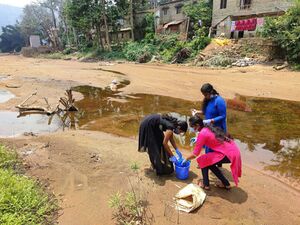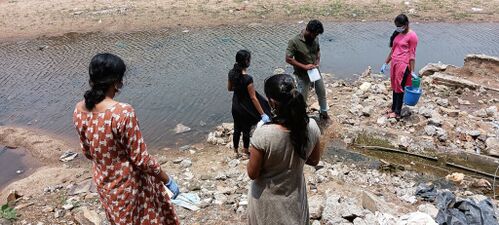Adopt a River: Difference between revisions
(Created page with "{{Project |Description=The Manimala River and its watershed are highly polluted by unchecked encroachments, dumping of domestic waste and thousands of litres of municipal sewage daily, destroying mountain wetlands, blocking springs and streams and polluting groundwater. This results in scarcity of drinking water, loss of biodiversity, and danger of floods and landslides. This project engages with the local community and administration to address these issues and secure t...") |
No edit summary |
||
| Line 13: | Line 13: | ||
# http://www.ties.org.in | # http://www.ties.org.in | ||
=Project Gallery= | |||
|Problems=43831 | |Problems=43831 | ||
| Line 21: | Line 24: | ||
|scraped_from=GlobalGiving | |scraped_from=GlobalGiving | ||
|feature_image=File:IMG_20210203_111542_Large.jpg|Water sample collection | |feature_image=File:IMG_20210203_111542_Large.jpg|Water sample collection | ||
|images=[[File:pict_large.jpg|Adopt a River,File:ph_40810_155985.jpg|,File:IMG_20220319_111201_Large.jpg|Algal Bloom filled pond at Karimbukayam,File:IMG_20220319_123636_Large.jpg|Drainage opening into Manimala River,File:IMG_20220319_082059_Large.jpg|Manimala River near Mallapally River,File:297134650_5243706559010461_8981726367751094965_n_Large.jpg|Waste accumulated at Pazhayidam causeway,File:kootikal_Large.jpg|Sample collection at Koottikkal & dried-up river,File:kuruvanmuzhi_Large.jpg|Sample collection at Kuruvamuzhi,File:mundakayam_Large.jpg|Mundakayam- The most polluted site,File:waste_mundakayam_Large.jpg|Municipal Waste at Mundakayam; dried river,File:dtd_30.jpeg|Accumulated plastic waste collecting]] | |images=[[File:pict_large.jpg|Adopt a River,File:ph_40810_155985.jpg|,File:IMG_20220319_111201_Large.jpg|Algal Bloom filled pond at Karimbukayam,File:IMG_20220319_123636_Large.jpg|Drainage opening into Manimala River,File:IMG_20220319_082059_Large.jpg|Manimala River near Mallapally River,File:297134650_5243706559010461_8981726367751094965_n_Large.jpg|Waste accumulated at Pazhayidam causeway,File:kootikal_Large.jpg|Sample collection at Koottikkal & dried-up river,File:kuruvanmuzhi_Large.jpg|Sample collection at Kuruvamuzhi,File:mundakayam_Large.jpg|Mundakayam- The most polluted site,File:waste_mundakayam_Large.jpg|Municipal Waste at Mundakayam; dried river,File:dtd_30.jpeg|Accumulated plastic waste collecting,]] | ||
|coordinate=, | |coordinate=, | ||
|geo_id=1269750}} | |geo_id=1269750}} | ||
Revision as of 08:33, 24 May 2023
| Organization | Tropical Institute of Ecological Sciences |
|---|---|
| Region | India |
| Website | Website |
| ProjectLeader | Punnen Kurian |
| Linked Problems & Solutions
|
|---|
The Manimala River and its watershed are highly polluted by unchecked encroachments, dumping of domestic waste and thousands of litres of municipal sewage daily, destroying mountain wetlands, blocking springs and streams and polluting groundwater. This results in scarcity of drinking water, loss of biodiversity, and danger of floods and landslides. This project engages with the local community and administration to address these issues and secure the Manimala River and 781 sqkm of watershed area
Challenge
The Manimala river provides drinking water and livelihoods to over 5 lac families living along its 90 km stretch. Untreated sewage, paper, plastic and food waste dumped into the water is degrading water quality and decimating local biodiversity. Unchecked encroachments in the watershed area is destroying crucial wetlands and blocking streams/springs feeding the river, impeding the free flow of water, substantially increases the risk of flash floods and landslides in a possible repeat of 2018.
Long-Term Impact
This project will rejuvenate more than 3000 springs and streams in 781 sqkm of watershed area feeding the 90-km long Manimala river. Over half a million people living in the area will benefit from improved drinking water quality and enhanced riverine biodiversity supporting livelihoods. In the long run, the project will secure entire watershed region and river all the way to where it drains into the Lake Vembanad and prevent a repeat of the 2018 flood disaster when so many lives were lost.
References
Project Gallery










